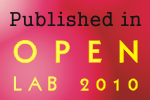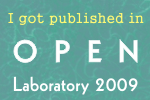Warren DeLano passed away suddenly and at a young age at his home Nov 3, 2009. He was the author of PyMol, a very popular molecular visualization program, and a strong advocate of open source software. The family of Warren Lyford DeLano has created a “In Memorium” page and blog. Also, a memorial award is […]
For those who are not in the structural biology community: Warren DeLano wrote and maintained PyMol, the software of choice for molecular visualization. Practically anyone who published anything requiring a biomolecular image used PyMol. It is a great piece of software, powerful and extensible. Warren was strongly committed to writing quality product that served the […]
This has been a topic of discussion since I was in grad school: when will the Nobel prize for the structure of the ribosome be finally awarded? Well, it finally has. Ada Yonath, Thomas Steitz and Venkatraman Ramakrishnan received the Nobel for work that has spanned three decades and an equal number of continents. […]
Proteins are the machinery of life, and they facilitate most of life’s functions. Traffic into and out of the cell? Protein pumps, pores and channels. Respiration? Proteins. Metabolism and catabolism? Proteins. Immune system, signaling, development… all complex networks of interacting proteins. Understanding a protein’s structure can tell us a lot about how it performs its […]
(Thanks to F.B. for the inspiration). Sigh… people don’t seem to learn. It’s been almost 22 years (yikes!) since a distinguished group of scientists published a letter in Cell calling for a responsible use of the word “homology”. If you were born when that letter was published, then in the US you can already drink […]
Maintaining a water balance is essential to life. Cells must regulate their water content carefully and within a very narrow margin. Too much water intake, and the cell bursts like a water balloon; too much water outflow, and it shrivels like a raisin. The cell itself is contained in a waterproof membrane. But there are […]
Harvard University has removed from YouTube the video I embedded in my Leonardo Da Vinci and the F0-F1 ATPase post, due to copyright concerns. It is a pity. I believe the main sufferer from this step is the lab that actually created this video, and now has one outlet less to publicize its work. One […]
Offspring #2 (O2) and I spent last weekend visiting the Da Vinci Experience exhibit at San Diego’s Air & Space Museum. The exhibit is engineer’s heaven: large wood models based on and inspired by LDV’s drawings. Gears, crankshafts, pulleys. O2 was interested in the military stuff: catapults, the tank , a mobile bridge. I did […]
Don’t you know We’re all light Yeah, I read that someplace –XTC This is interesting: an article in PLoS ONE that claims that Paramecia can communicate using light. The author, Daniel Fels from the Swiss Tropical Institute in Basel, separated two Paramecia populations using quartz or glass vials, grew them in the dark, and checked […]
In the latter epoch of those 2 billion-odd years between non-life and life on early Earth, our ancestral molecular replicators were quite probably RNA, not DNA. There are many arguments for this RNA world hypothesis: RNA can store information in its sequence, and self -duplicate; it can also catalyze reactions as a ribozyme. So technically, […]
We learned in high school and/or undergrad biology that one antibody would bind to one antigen. This is what makes our immune system so effective: antibodies bind with high affinity to foreign proteins or other molecules. Not only that, but those antibodies are specific: they would bind only to a specific site on the foreign […]
Beware the temptation to use the 45 and 120 degree angle pink and yellow light source, in combination with shiny plastic B-splines, which would make your protein model look like brothel decor
Happy Pi (π) Day! Americans write dates in the MM/DD/YYYY format instead of the DD/MM/YYYY format used by the rest of the world. Usually a rather painful and confusing format if you did not grow up with it, causing checks to bounce and leases to expire for those who recently moved to the US, but […]
Gradualism is a cornerstone principle in evolution. Things happen in small increments; all the time that changes happen, overall organism fitness cannot be compromised. So how then do full-featured complex functions appear? One way is by functional re-purposing of an existing organ: …an organ may become rudimentary for its proper purpose, and be used for […]





